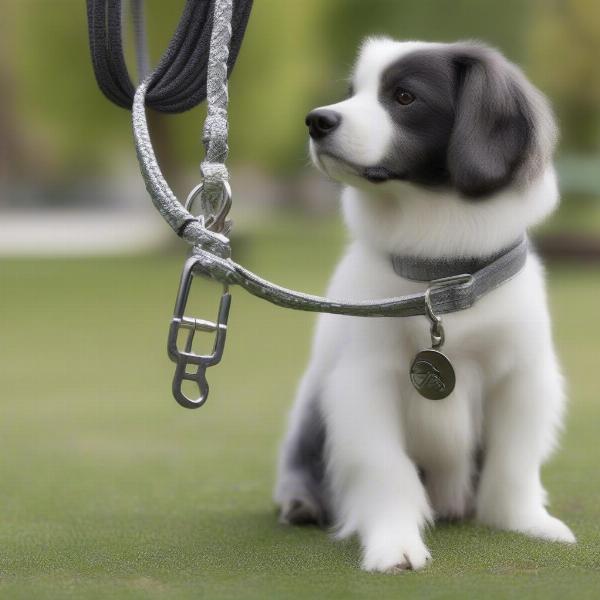A dog lead, also known as a leash, is an essential tool for any dog owner. It provides control, safety, and a connection between you and your furry friend. When choosing a dog lead, one popular option is the metal dog lead. This article will explore the advantages and disadvantages of metal dog leads, helping you determine if it’s the right choice for your canine companion.
Metal Dog Leads: Pros and Cons
Metal dog leads have been a staple for dog owners for years. They are known for their durability and strength. However, like any product, they come with their own set of advantages and disadvantages.
Advantages of Metal Dog Leads
- Durability: Metal leads, particularly those made from stainless steel, are incredibly durable and can withstand a lot of wear and tear. This makes them a good choice for strong or energetic dogs who may chew or pull on their leads.
- Strength: Metal leads offer superior strength compared to other materials like nylon or fabric. This provides better control, especially for larger breeds or dogs prone to pulling.
- Easy to Clean: Metal leads are simple to clean. Often, a quick wipe with a damp cloth is all that’s needed.
- Weather Resistant: Unlike fabric leads that can absorb moisture and become moldy, metal leads are resistant to weather elements.
Disadvantages of Metal Dog Leads
- Weight: Metal leads can be heavier than other options, which can be uncomfortable for both the dog and the owner, especially during long walks.
- Noise: Metal leads can make a jingling or clinking noise, which can be distracting for some dogs and owners.
- Potential for Injury: In certain situations, metal leads, especially chain leads, can cause injuries to the dog’s neck if they pull suddenly or the owner uses harsh corrections.
- Temperature Sensitivity: Metal leads can become very hot in the sun and very cold in the winter, making them uncomfortable for the dog to handle.
Types of Metal Dog Leads
There are several types of metal dog leads available, each with its own specific characteristics:
- Chain Leads: These are the most traditional type of metal lead, known for their strength and durability. However, they can be heavy and noisy.
- Slip Leads: These leads tighten around the dog’s neck when they pull, providing more control. However, they can be uncomfortable and potentially harmful if not used correctly.
- Cable Leads: These are generally lighter and more flexible than chain leads, offering a good balance of strength and comfort.
Choosing the Right Metal Dog Lead for Your Dog
When choosing a metal dog lead, consider the following factors:
- Dog’s Size and Breed: A larger, stronger dog will require a thicker and more durable lead than a smaller dog.
- Dog’s Temperament: For dogs that pull excessively, a slip lead or a strong cable lead might be considered. However, training is always the preferred method for managing pulling.
- Lead Length: Consider the activities you’ll be doing with your dog. A shorter lead is better for training and crowded areas, while a longer lead provides more freedom for exploring.
- Climate: In hot climates, consider a lighter-colored metal lead to reflect sunlight and prevent overheating.
 Comparing Different Metal Dog Leads
Comparing Different Metal Dog Leads
Conclusion
Metal dog leads can be a good choice for certain dogs and owners, offering durability and strength. However, it’s crucial to weigh the pros and cons carefully and consider your dog’s individual needs and temperament. With careful consideration and proper training, you can choose the right metal dog lead to ensure both your dog’s safety and comfort. Remember that a dog metal lead is just one tool in your dog-owning arsenal, and proper training and handling techniques are essential.
FAQs
- Are metal dog leads safe for puppies? Generally, it’s best to avoid metal leads for puppies as their necks are delicate. A lightweight nylon or fabric lead is a better option.
- Can I use a metal lead for training? A metal lead dog can be used for training, but lighter options are often preferred for better maneuverability.
- How do I clean a metal dog lead? Simply wipe it down with a damp cloth and dry thoroughly.
- What if my dog chews on their metal lead? While durable, some dogs may still try to chew on metal leads. If this happens, try distracting them with a chew toy or consider a different lead material.
- Are metal leads suitable for all weather conditions? Yes, metal leads are generally weather-resistant. However, they can become hot or cold in extreme temperatures.
- Can a metal lead hurt my dog? Improper use, especially with chain or slip leads, can cause injury. Always ensure proper fit and gentle handling.
- What length of metal lead should I choose? Consider your dog’s size, temperament, and the activities you’ll be doing together.
ILM Dog is a leading international website dedicated to providing expert advice and resources for dog owners worldwide. We cover a wide range of topics, from breed selection and puppy care to dog training, nutrition, and health. We even offer information on products and accessories like a baseball dog collar. If you’re considering other options for securing your property, we also have a helpful article about dog ear fencing. Furthermore, if you are worried about a cut on dogs paw, please contact us directly. With a focus on providing practical, reliable information, ILM Dog helps dog owners make informed decisions to ensure their furry friends live happy, healthy lives. Contact us at [email protected] or +44 20-3965-8624.